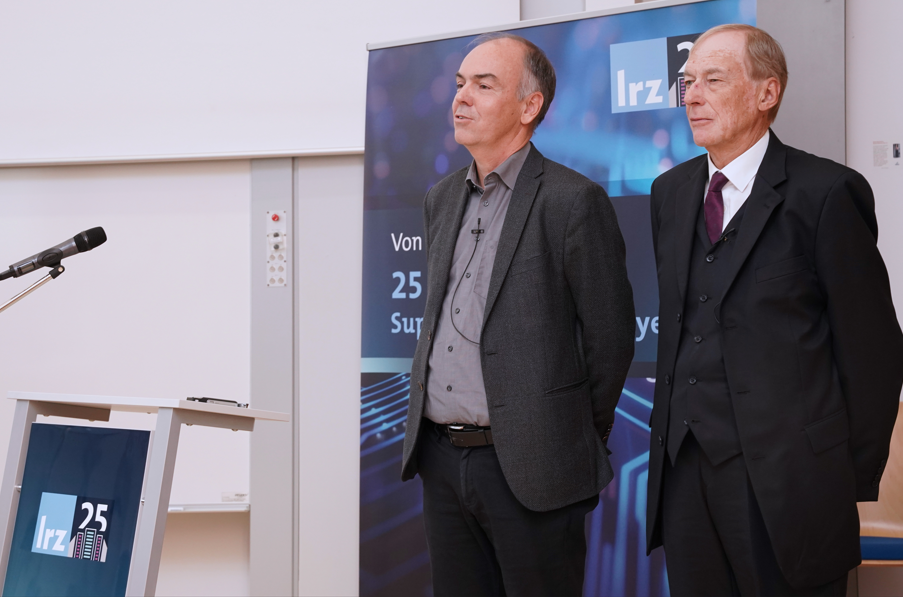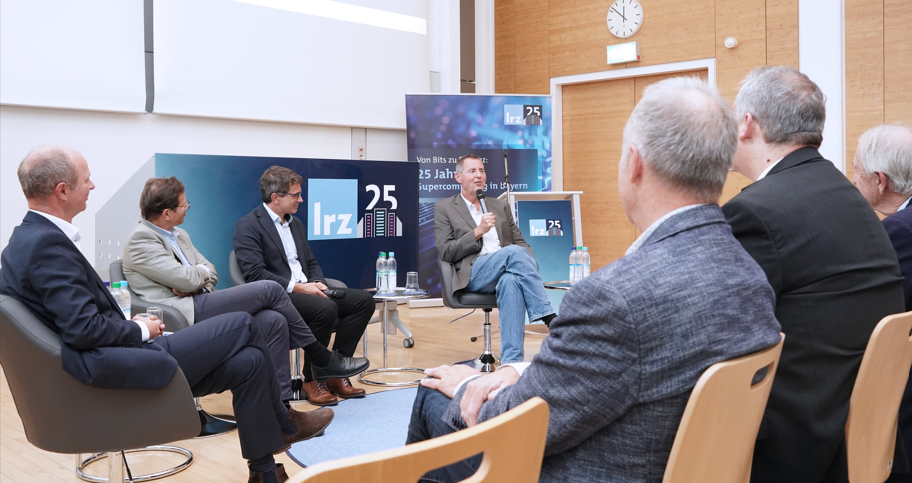NEWS
LRZ Celebrates 25 Years of National High-Performance Computing
14/Newsflash –
In 2000, a Bavarian system was ranked fifth among the world’s fastest supercomputers. The “High-Performance Computer Bavaria,” or HLRB 1, achieved 1.6 gigaFLOPS, or 1.6 billion floating point operations per second. The system was installed at the Leibniz Supercomputing Centre (LRZ), and while it was not LRZ’s first supercomputer, it marked the center’s entry into national high-performance computing (HPC).
On October 13, 2025, LRZ celebrated 25 years of national high-performance computing. Distinguished speakers and companions guided the audience through a quarter century of HPC history at LRZ.

Image: LRZ

Image: LRZ
By 2007, LRZ joined the High-Performance Computing Center Stuttgart and Jülich Supercomputing Centre to form GCS, raising Germany’s profile as an international leader in HPC. Since becoming a national center, LRZ’s computing power has increased by roughly tenfold every four years, with storage capacity increasing at an even faster rate—doubling every year to 14 months. While rankings of the world’s fastest HPC systems change every six months, the event showcased what LRZ has kept in focus during its existence: supporting scientific productivity. The center looked back on several highlights, such as:
- Under the lead of scientists at the Technical University of Munich (TUM), LRZ supercomputers produced a revolutionary model of the human lung. The research showed that the organ was not grape-shaped, but rather sponge-like and larger than the skin when unfolded.
- Researchers at Ludwig-Maximilians-Universität Munich (LMU) used SuperMUC to simulate the formation of the Earth's continents over millions of years, as well as the processes occurring within their cores and crusts. The fascinating images resulting from this simulation are now on display at the American Museum of Natural History in New York.
- In 2013, the 1Kite project used SuperMUC to reconstruct the family tree of insects and birds. These fundamental biological findings remain among the most frequently cited results in the field.
- For the Millennium TNG astrophysics project, led by the Max Planck Institute for Astrophysics (MPA), LRZ's HPC systems simulated dark matter several times. This led to the discovery and measurement of neutrinos, among other things.
The center has long prided itself on a diverse user community, with its systems supporting traditional HPC power users in the field of astrophysics, thermodynamics, chemistry, and engineering, but also biologists, pharmacologists, climate researchers, and humanities researchers. Since 2000, the center has actively promoted the Competence Network for Scientific High-Performance Computing (KONWIHR), funded by the Bavarian Ministry of Science. Over the years, KONWIHR has helped bring together expertise and HPC capabilities to support scientists in developing and optimizing codes, ultimately maximizing the potential of each generation of HPC systems at the centers.
Over the years, LRZ has had a particular focus on delivering not only the best-possible systems for science, but also making sure that its expansive IT infrastructure runs as efficiently as possible. The center developed hot-water cooling systems alongside technology partner IBM in 2012, and the center’s current flagship system, SuperMUC-NG, is the first supercomputer that cools exclusively with hot water.
As the center begins its second quarter century of supporting science as a national HPC center, the future of the field is also becoming increasingly clear: with the expansion of SuperMUC-NG, planning for Blue Lion underway, and acquisition of next-generation quantum and photonic prototype systems, the center is bolstering not only hardware for classical modelling and simulation, but also supporting the increasing demand for GPU-accelerated, AI-capable supercomputers and serving as a laboratory for new computing paradigms that can accelerate scientific discovery.
Prof. Dr. Dieter Kranzlmüller, Chairman of the Board of Directors of LRZ and Chairman of the Board of Directors of GCS:
“Our actions and our own research are driven by the desire to help science arrive more quickly at insights that will help solve global challenges. We are rather proud that, within the GCS network, we are the computing centre for a very broad user community and can devote ourselves entirely to the service of research.”
To read the full report on LRZ’s 25th anniversary celebration, read the center’s press release.